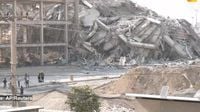On March 28, 2025, at approximately 12:50 PM local time (2:20 PM Taiwan time), a magnitude 7.7 earthquake struck central Myanmar, sending shockwaves across the region and beyond. The epicenter was located 16 kilometers northwest of Sagaing, with a shallow depth of just 10 kilometers, according to the U.S. Geological Survey (USGS) and the German Research Center for Geosciences (GFZ). This earthquake’s shallow depth and intensity have raised concerns about significant surface impacts, although specific casualty and damage reports remain elusive due to the ongoing internal conflicts within the country.
The tremors were felt widely, affecting not only Myanmar but also neighboring countries including Thailand, Vietnam, India, and Bangladesh. In Thailand's capital, Bangkok, approximately 700 kilometers from the epicenter, high-rise buildings swayed noticeably, prompting widespread panic and evacuations. Videos posted on social media captured scenes of people fleeing buildings, while some residents reported feeling dizzy as they experienced the shaking. One Chiang Mai resident recounted, "I was sleeping when I heard a noise and immediately ran outside in my pajamas." Meanwhile, light tremors were also reported in parts of India’s Delhi-NCR and regions of Yunnan and Sichuan in China.
As the dust settled, the full extent of the damage began to emerge. The earthquake's epicenter was near Mandalay, Myanmar's second-largest city, where residents experienced strong shaking. Although Myanmar officials have not released detailed casualty or damage reports, the military government declared a state of emergency in six regions, including Sagaing. A rescue team member in Yangon, Myanmar's largest city, described the damage as "widespread," estimating that there could be hundreds of casualties. Eyewitnesses reported hearing sirens from emergency vehicles in the streets of Yangon.
Internationally, the Japan Meteorological Agency confirmed that the earthquake posed no tsunami threat to coastal Japan. However, the aftermath of the quake has raised alarms, particularly due to Myanmar's tumultuous political climate. The country has been under military rule since a coup in 2021, which has led to media restrictions and limited communication capabilities, complicating rescue and recovery efforts. The international community is closely monitoring the situation, hoping for timely updates on the disaster's impact.
In Thailand, the earthquake's effects were severe, with reports of a newly constructed 30-story office building collapsing in Bangkok. Government officials indicated that around 80 construction workers were unaccounted for after the incident, and approximately 320 people were present at the site when the building fell. The National Institute for Emergency Medicine in Thailand confirmed that 20 individuals were trapped in an elevator at the construction site during the collapse.
Experts have noted that Myanmar lies at the intersection of the Eurasian and Indo-Australian tectonic plates, making it prone to seismic activity. The Sagaing Fault, a major seismic zone in the region, has historically been associated with significant earthquakes. Data indicates that Myanmar experiences around 720 earthquakes annually, with magnitude 7 or greater earthquakes occurring approximately every four to five years. This recent earthquake is potentially the most destructive since the 1839 Ava earthquake, which was recorded at 8.3 in magnitude.
In light of the recent disaster, Thai authorities have activated emergency response measures, inspecting building safety and urging the public to remain vigilant. The Thai government is working to ensure that all necessary precautions are taken as the situation develops. As more information becomes available, there is hope that Myanmar will be able to provide a comprehensive assessment of the damage, facilitating international aid efforts.
In the wake of the earthquake, predictions made earlier this year by a local fortune teller, Master Seven, have gained attention. She had warned of potential disasters in the region, specifically advising against travel in April and suggesting that people stay in Hong Kong for safety. Her predictions included the possibility of air disasters and emphasized the need for caution when traveling.
As the dust settles and recovery efforts begin, the situation in Myanmar remains precarious. The combination of natural disaster and political instability poses significant challenges for the affected communities. With communication lines potentially hindered and rescue operations complicated by the military government’s restrictions, the international community watches closely, offering support and assistance where possible.
This earthquake serves as a stark reminder of the geological volatility of the region and the ongoing difficulties faced by the people of Myanmar. As they navigate the aftermath, the resilience of the affected communities will be crucial in overcoming the challenges ahead.







